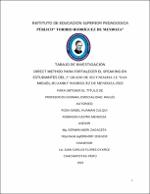| dc.contributor.advisor | Mg. Mori Zagaceta, German | es_PE |
| dc.contributor.author | Huaman Culqui, Rosa Isabel | es_PE |
| dc.contributor.author | Castro Mendoza, Robinson | es_PE |
| dc.date.accessioned | 2025-07-16T22:20:59Z | |
| dc.date.available | 2025-07-16T22:20:59Z | |
| dc.date.issued | 2023-12-27 | |
| dc.identifier.uri | http://hdl.handle.net/123456789/55 | |
| dc.description.abstract | The present research report, entitled "Direct Method to Strengthen Speaking,"
aimed to determine the effectiveness of the Direct Method in strengthening speaking skills
among 2nd-grade secondary students at the "San Miguel-Huambo" Rodríguez de
Mendoza Educational Institution. The research followed an applied approach with a
quantitative focus and a pre-experimental design. A probabilistic sampling method was
employed, involving 15 students from the 2nd grade, selected through observation
techniques and using evaluation rubrics and checklists as instruments. The report focuses
on two variables: the direct method and speaking skills. 20 sessions were conducted and
evaluated using a checklist to demonstrate the levels of achievement. The research
included both pre-tests and post-tests administered to the same group of students. The
selection of the sample was carried out through probabilistic sampling, with 15 students
from the 2nd grade chosen using observation techniques and the instruments of evaluation
rubrics and checklists. The report concludes with the analysis of the data obtained from
the pre-test and post-test assessments, specifically using an evaluation rubric. The
findingsrevealed that, based on the evaluation rubric, the application of the Direct Method
significantly impacted the speaking skills of the 2nd-grade students. In the pre-test, 16
students were at the beginning level (0 in process, 0 achieved, 0 outstanding). After the
post-test, one student reached the outstanding level, 14 students achieved the desired level,
while none remained at the process level, and none were at the beginning level | es_PE |
| dc.description.tableofcontents | RESUMEN........................................................................................................................iii
ABSTRACT......................................................................................................................iv
DEDICATORIA.................................................................................................................v
AGRADECIMIENTO.......................................................................................................vi
ÍNDICE DE TABLAS ......................................................................................................xi
ÍNDICE DE FIGURAS....................................................................................................xii
INTRODUCCIÓN ...........................................................................................................13
CAPÍTULO I....................................................................................................................14
PLANTEAMIENTO DEL PROBLEMA.........................................................................14
1.1. Descripción de la realidad problemática ...........................................................15
1.2. Formulación del problema................................................................................18
1.2.1 Problema principal .....................................................................................18
1.2.2 Problemas específicos................................................................................18
1.3. Objetivos de la investigación............................................................................18
1.3.1. Objetivo general:........................................................................................18
1.3.2. Objetivos específicos: ................................................................................18
1.4. Formulación de la hipótesis..............................................................................19
1.4.1. Hipótesis general. .......................................................................................19
1.4.2. Hipótesis específicas. .................................................................................19
1.5. Justificación de la investigación........................................................................19
CAPÍTULO II ..................................................................................................................21
MARCO TEÓRICO.........................................................................................................21
2. MARCO TEÓRICO.....................................................................................................22
2.1 Antecedentes.....................................................................................................22
2.1.1. Antecedentes internacionales. .........................................................................22
2.1.2. A nivel nacional ..............................................................................................23
2.1.3. A nivel regional / local....................................................................................24
2.2 Bases teóricas.....................................................................................................24
2.2.1 El método directo. ............................................................................................24
2.2.1.1. origen. ..........................................................................................................24
2.2.1.2 Definición. .....................................................................................................24
2.2.1.3. Técnicas que se utiliza con el método directo..............................................25
2.2.1.4. Beneficios del método directo. .....................................................................25
2.2.1.5. El uso de material audio visual motiva al estudiante. .........................................26
2.2.1.6. Teoría que aportan al aprendizaje de una segunda lengua.........................26
2.2.2. El speaking .....................................................................................................27
2.2.2.1. Dimensiones del speaking ............................................................................28
2.2.2.2. Estrategia para la enseñanza del speaking..................................................29
2.2.2.3. Importancia del speaking .............................................................................31
2.2.2.4. Propuesta lúdica para el speaking...............................................................31
2.2.2.5. Mejoramiento del speaking en el idioma inglés...........................................32
2.2.2.6. Ventajas del speaking en el inglés................................................................34
2.2.2.7. Herramientas para fortalecer el speaking en el inglés. ...............................34
2.2.2.8. Teoría sociocultural de Vygotsky .................................................................34
2.3. MARCO CONCEPTUAL..................................................................................35
CAPITULO III.................................................................................................................38
METODOLOGIA DE LA INVESTIGACIÓN................................................................38
3. METODOLOGIA DE LA INVESTIGACIÓN....................................................39
3.1. Identificación De Variable Y Su Definición Conceptual Operacional. ...........39
3.1.1. Variable independiente: El Direct Method......................................................39
3.1.2. Variable dependiente: El Speaking. ................................................................39
3.2. TIPO, NIVEL Y DISEÑO DE LA INVESTIGACIÓN....................................40
3.2.1. Tipo .................................................................................................................40
3.2.2. Nivel de investigación. ....................................................................................40
3.2.3. Deseño de investigación..................................................................................41
3.3. POBLACIÓN Y MUESTRA............................................................................41
3.3.1 Población ..........................................................................................................41
3.3.2. Muestra............................................................................................................42
Fuente: Nómina de matrícula segundo grado 2023.................................................42
3.4. TÉCNICAS E INSTRUMENTO DE RECOLECCIÓN DE DATOS. .....................42
3.4.1 Técnicas............................................................................................................43
A. Entrevista .......................................................................................................43
B. Encuesta.............................................................................................................43
C. Observación ..........................................................................................................43
3.4.2. Instrumentos de recolección de datos..............................................................44
A. Lista de cotejo .....................................................................................................44
B. Cuestionario..........................................................................................................44
3.5. PROCESO DE PRUEBA DE HIPÓTESIS Y ANÁLISIS DE DATOS...........45
CUARTO CAPÍTULO IV ...............................................................................................47
DESCRIPCION DE RESULTADOS ..............................................................................47
4. DESCRIPCION DE LOS RESULTADOS.................................................................48
4.1. Análisis de la prueba de entrada del grupo experimental (Pre test). .................48
4.1.2 Análisis de resultados de las dimensiones del Speaking...........................50
4.1.3 Análisis de la prueba de salida del grupo experimental (post test). ...........53
4.1.4 Análisis de los niveles de logros alcanzados (Pre test y post test).............55
CAPITULO V..................................................................................................................57
DISCUSIÓN, CONCLUSIONES Y SUGERENCIAS....................................................57
5.1. DISCUSIÓN......................................................................................................58
5.2. CONCLUSIONES ....................................................................................................62
5.3. SUGERENCIAS .......................................................................................................63
REFERENCIAS BIBLIOGRÁFICAS.............................................................................64
ANEXOS..........................................................................................................................68
Hipótesis general:........................................................................................................2
CONSTANCIA DE EJECUCION DE PROYECTO DE INVESTIGACION ..................6
HACE CONSTAR.....................................................................................................6
INFORME DE EXPERTOS ..............................................................................................3 | es_PE |
| dc.format | application/pdf | es_PE |
| dc.language.iso | spa | es_PE |
| dc.relation | DIRECT METHOD PARA FORTALECER EL SPEAKING EN ESTUDIANTES DEL 2° GRADO DE SECUNDARIA I.E “SAN MIGUEL-HUAMBO” RODRÍGUEZ DE MENDOZA-2023 | es_PE |
| dc.relation.uri | Investigación | es_PE |
| dc.rights | info:eu-repo/semantics/openAccess | es_PE |
| dc.subject | Investigación | es_PE |
| dc.title | DIRECT METHOD PARA FORTALECER EL SPEAKING EN ESTUDIANTES DEL 2° GRADO DE SECUNDARIA I.E “SAN MIGUEL-HUAMBO” RODRÍGUEZ DE MENDOZA-2023 | es_PE |
| dc.type | info:eu-repo/semantics/bachelorThesis | es_PE |
| dc.type.version | info:eu-repo/semantics/publishedVersion | es_PE |
| dc.publisher.country | PE | es_PE |
| dc.subject.ocde | https://purl.org/pe-repo/ocde/ford#5.03.00 | es_PE |
| renati.author.dni | 71142280 | |
| renati.author.dni | 42392804 | |
| renati.advisor.orcid | https://orcid.org/0009-0007-1919-5150 | es_PE |
| renati.advisor.dni | 30193729 | |
| renati.type | https://purl.org/pe-repo/renati/type#trabajoDeInvestigacion | es_PE |
| renati.level | https://purl.org/pe-repo/renati/nivel#tituloProfesional | es_PE |
| renati.juror | S: Lic. Perla Karina Valdez Àlvarez | es_PE |
| renati.juror | V: Lic. Alida Ynga Valdivia | es_PE |
| renati.juror | P: Mg. Fanny Cruz Lopez | es_PE |
| thesis.degree.name | Profesor/a en Idiomas, Especialidad: Ingles | es_PE |
| thesis.degree.grantor | Instituto de Educación Superior Público Pedagógico "Toribio Rodríguez de Mendoza" | es_PE |
| thesis.degree.discipline | Educación Secundaria, Especialidad Inglés | es_PE |



